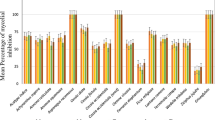Abstract
In order to develop new anti-inflammatory agents having different action mechanisms compared with nonsteroidal and steroidal anti-inflammatory drugs, the culture broths of various actinomycetes isolated from soil were screened using anin vivo mouse ear edma assay and one strain (Streptomyces sp. MT 2705-4: KCTC 8651P) was selected. Activity-guided purification led to the isolation of a polyether compound, dianemycin. Topically, dianemycin showed a potent anti-inflammatory activity in mouse ear edema induced by croton-oil or arachidonic acid. ED50 value of dianemycin was found to be 0.8 mg/ear compared to 0.4 mg/ear of prednisolone in croton-oil ear edema. However, dianemycin did not show the inhibitory activity in UV-erythema and delayed hypersensitivity reaction. These results indicate that dianemycin is a potential topical anti-inflammatory agent.
Similar content being viewed by others
References Cited
Buclier, M., Cavey, D., Kail, N. and Hensby, C., Experimental models in skin pharmacology.Pharmacol. Rev., 42, 127–153 (1990).
Hamill, R. L., Hoehn, M. M., Pittenger, G. E., Chamberlin, J. and Gorman, M., Dianemycin, an antibiotic of the group affecting ion transport.J. Antibiotics, 22, 161–164 (1969).
Kim, H. K., Namgoong, S. Y. and Kim, H. P., Anti-inflammatory activity of flavonoids: Mouse ear edma inhibition.Arch. Pharm. Res., 16, 18–24 (1993).
Kim, H. P., Glucocorticoids: Anti-inflammation and immunosuppression.Korean Biochem. News, 10, 246–251 (1990).
Law, E. and Lewis, A. J., The effect of systemically and topically applied drugs on ultraviolet induced erythema in the rat.Br. J. Pharmacol., 59, 591–597 (1977).
Lubach, D. and Kietzmann, M., Anti-inflammatory effect and thinning of the skin: Models for testing topically applied corticoids on human skin., In, (Maibacu, H. J. Ed.)Topical corticoids, S. Karger, pp. 26–41, 1992.
Mheen, T. I., Ahn, J. S., Yoon, B. D., Lee, H. S., Ahn, S. C. and Park, C. S., Screening of the novel bioactive substances from actinomycetes (III).,Report for Ministry of Science and Technology, BSN 71021-239-3 (1990).
Namgoong, S. Y., Son, K. H., Chang, H. W., Kang, S. S. and Kim, H. P., Effects of naturally-occurring flavonoids on mitogen-induced lymphocyte proliferation and mixed lymphocyte culture.Life Sci., 54, 313–320 (1994).
Rao, T. S., Currie, J. L., Shaffer, A. F. and Isakson, P. C., Comparative evaluation of arachidonic acid (AA)- and tetradecanoylphorbol acetate (TPA)-induced dermal inflammation.Inflammation, 17, 723–741 (1993).
Settipane, G. A., Adverse reaction of aspirin and related drugs,Arch. Intern. Med., 141, 328–332 (1981).
Tarayre, J. P., Barbara, M., Aliaga, M. and Tisne-Versailles, J., Comparative actions of immunosuppressants, glucocorticoids and non-steroidal anti-inflammatory drugs on various models of delayed hypersensitivity and on a non-immune inflammation in mice.Arzneim.-Forsch./Drug Res., 40, 1125–1131 (1990).
Tonneli, G., Thiabault, L. and Ringler, I., A bioassay for the concommitent assessment of the antiphlogistic and thymolytic activities of topically applied corticoids.Endocrinol., 77, 625–634 (1965).
Young, J. M., Spires, D. A., Bedord, C. J., Wagner, B., Ballaron, S. J. and De Young, L. M., The mouse ear inflammatory response to topical arachidonic acid.J. Invest. Dermatol., 82, 367–371 (1984).
Author information
Authors and Affiliations
Rights and permissions
About this article
Cite this article
Lee, S.J., Kim, H.P., Park, B.K. et al. Topical anti-inflammatory activity of dianemycin isolated fromStreptomyces sp. MT 2705-4. Arch. Pharm. Res. 20, 372–374 (1997). https://doi.org/10.1007/BF02976203
Received:
Issue Date:
DOI: https://doi.org/10.1007/BF02976203




